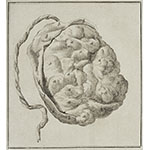Bundle of blood vessels through which nutritive exchanges occur between the fetus and the mother. The umbilical vessels include the vein carrying arterial blood from the placenta to the fetus, and the two umbilical arteries carrying venous blood from the fetus to the placenta. The mean length from the maternal placenta to the abdominal wall is 50 centimeters. The umbilical cord is cut at birth, after the independent circulation and respiration of the fetus has begun. As a rule, the umbilical cord is inserted at the center of the placenta. When it is inserted peripherally, the vessels may be ruptured or compressed during birth, causing fetal distress. When the umbilical cord is too short, i.e., under 30 centimeters, the fetus may have difficulty progressing in the birth canal. When the umbilical cord is more than 80 centimeters long, knots or windings may form around the fetus. Prolapsus of the umbilical cord is the presence of one or more lengths of cord in front of the fetus in the birth canal during labor. In these cases an emergency Cesarean section is indicated.








